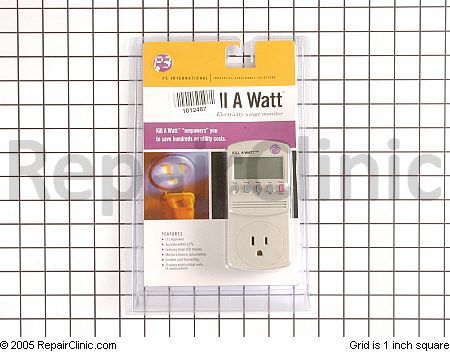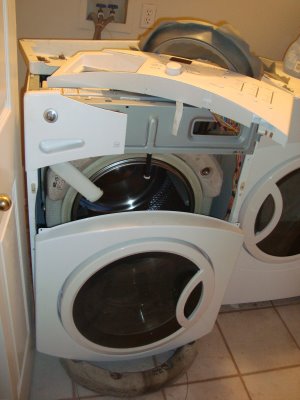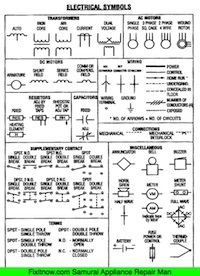Who made your Kenmore appliance? Use this magical Kenmore model number decoder to find out. http://flic.kr/p/8zYtZh
Category Archives: General Appliance Wisdom
Tech Tip o’ Da Week: Terminal …
Tech Tip o’ Da Week: Terminal Wisdom http://j.mp/czSWbt
Washing Machine Installation i…
Washing Machine Installation in a Medical Marijuana Facility… http://post.ly/w2xP
Kenmore Laundry Appliances Will Connect for Remote Diagnosis
A new customer service technology, Kenmore Connect, enables some Kenmore and Kenmore Elite washers and dryers to communicate directly to service experts. The technology lets customers find out if their appliance is running correctly or receive instructions with a phone call and a push of a button. The system sends real-time diagnostic information from the appliance to service staff who can offer assistance and solutions to customers.
Kenmore’s field testing results showed a significant reduction in the need for in-home visits for customers who used the feature.
The appliances do not need to be hard-wired to send their information. To send information, the customer holds the phone mouthpiece over the appliance power button and press a button on the appliance to send the diagnostic data.
Service personnel can monitor more than 100 different data points to diagnose the unit and offer a solution. The data includes cycle and option settings, operational information (e.g., air/water temperature, estimated load size, spin speeds, fill/drain times, unbalanced load issues, etc.), details on the factors that contribute to the cycle time, status of certain electrical and mechanical sub-systems, and the mechanical issues associated with each error code.
This article gives the impression that Kenmore, a Sears marketing brand, is developing this technology in-house. I can guarantee you this isn’t the case. The Kenmore “factory” is a floor of offices on the Sears Tower where corporate suits make phone calls to other corporate suits who work for companies that really do make things, like Whirlpool or LG. No hints on who is providing this technology for Kenmore but I know for a fact that Whirlpool, Miele and most of the other manufacturers have already started implementing this feature in some of their models. Soon, as appliances become more computerized, they’ll all have it. Heck, they’ll *need* this feature just to be able to troubleshoot ’em!
But the real reason for all this connectivity is more insidious than just the gee-whiz factor or for diagnostic help. It’s also to make future appliances more compatible with– and controlled by– the coming Smart Grid. More on Big Brother’s Smart Grid here:
http://fixitnow.com/wp/2010/01/14/smart-grid-green-dream-or-just-another-big-brother-control-grid/
I don’t believe for a minute that the only data they’ll be sending is diagnostic info on the appliance. They’ll be collecting and sending all kinds of information; for example, how often you do laundry and is this “too often” (as determined by soon-to-be-announced government “standards”), are you using HE detergent, and are you using too much detergent. And just like it’s come out now that there are audio listening devices in your computer router, digital television set, and the NSA randomly listens in on your computer microphone and cell phone, you can be certain that this remote “diagnosis” will be yet another way for you to be surveilled.
But I’m not a big fan of all this computerization for another very practical reason: from a reliability standpoint, they SUCK! The electronics used in appliances are not near the robustness and quality of electronics used in cars, for instance. They fail at much higher frequency and at much greater expense than the simple, rugged mechanical controls they replaced. And let us not forget the 5th Law of the Prophecy: “Electronics and wet appliances do not mix.”
Can I hear an “Amen?”
Dirty electricity in your home…
Dirty electricity in your home harms your appliances *and* your body; now it’s personal! http://post.ly/unIF
Estimating Home Appliance Energy Use
Lots of folks today are struggling to save shekels in this broke-back economy and that’s ezzacly why the Samurai’s here. One budget item that many households don’t have a good handle on is the electric bill. With just a little information from the appliance name plate and some third-grade math using a calcumulator, the Samurai’s gonna show you how to quickly and easily figger out how much electricity each of your appliances, large and small, are using.
Just like in a budget, you usually can’t point to any one item and say, “Aha! There’s the big money drainer!” Instead, it’s usually a process of “death by a thousand cuts”– trimming a few pennies here and a few pennies there and, next thing you know, you’ve saved some real money.
Wattage
Watts are the basic unit of power use and consumption. You can usually find the wattage of most appliances stamped on the bottom or back of the appliance, or on its nameplate. The wattage stamped on the appliance is the maximum power drawn by the appliance.
Kilowatts are just watts x 1000. Your power meter actually measures kilowatts over a period of time, called kilowatt-hours (abbreviated kWh). This is simply the amount of kilowatts your home is sucking off the grid times the number of hours. This is the sum total of all electricity usage going in your home at any given time.
Since many appliances have a range of settings (for example, the speed of a washing machine spin or the heat setting on a dryer), the actual amount of power consumed depends on the actual setting used when you run the appliance.
All this will become clear when we work through some ezzamples so hang with me…
Special note for refrigerators: For older models, you can estimate the number of hours that a refrigerator actually operates at its maximum wattage by dividing the total time the refrigerator is plugged in by three. Even though it’s “turned on” all the time, the refrigerator compressor actually cycles on and off as needed to maintain interior temperatures.
Newer refrigerators with the variable capacity compressors (VCC) are a little different. They’ll actually vary the speed at which the compressor runs which affects its power consumption. In theory, this reduces the power consumption so if you used the “divide by three” method, you’ll come up with a higher power consumption than it’s actually using.
One solution for finding the power consumption on these newer refrigerators is to use the Kitt-a-Watt meter (discussed below) to directly measure the refrigerator’s power usage.
Formula for Estimating Energy Consumption
Let’s start with some third-grade math. Here’s a simple way to estimate appliance energy consumption.
(Wattage × Hours Used Per Day) / 1000 = Daily Kilowatt-hour (kWh) consumption
Now, multiply this by the number of days you use the appliance during the year for the annual consumption. You can then calculate the annual cost to run an appliance by multiplying the kWh per year by your local utility’s rate (on your power bill) per kWh consumed.
Now for those promised examples:
Window fan:
Suppose you have a window fan that has a watt rating of 200 watts stamped on its nameplate and you use it four hours/day about four months out of the year. And suppose your power rate is 8.5 cents/kWh (this is pretty cheap power, BTW– up here in Yankeeland, we pay over 18 cents/kWh! The rate will vary widely– check your power bill for your actual rate). Let’s see how much that sucker’s costing you:
(200 Watts × 4 hours/day × 120 days/year) / 1000
= 96 kWh × 8.5 cents/kWh
= $8.16/year
Easy as pie, da tovarish?
Let’s tackle another one…
Personal Computer and Monitor:
Suppose the compooter on your desktop has a wattage rating of 120 watts stamped on its nameplate or somewhere in the manufacturer’s tech specs. Let’s also suppose the monitor you’re using to read this web page has a rating of 150 watts and you use your compooter about four hours per day, year ’round. Again, we’re just using the power rate of 8.5 cents/kWh for an example. So how much is that costing you?
(120 + 150 Watts × 4 hours/day × 365 days/year) / 1000
= 394 kWh × 8.5 cents/kWh
= $33.51/year
Sometimes, the wattage isn’t stamped on the appliance and they might only give the amps instead. Amps is a measure of the electric current draw; it’s a measure of flow like gallons per minute from the BP oil gusher, same idea.
If the wattage is not listed on the appliance, you can still estimate it by finding the current draw (in amperes) and multiplying that by the voltage used by the appliance. Most appliances in the United States use 120 volts AC (vac). Larger appliances, such as electric clothes dryers and electric cooktops, use 240 vac (gas clothes dryers use 120 vac).
If the amps aren’t stamped on the appliance anywhere, you can easily measure it with a nifty and inexpensive gadget called a Kill-a-Watt meter. You just plug the Kill-a-Watt into the wall, then plug the appliance into the Kill-a-Watt meter and you’ll read the amps, watts, and volts right on the meter. No fuss, no muss! Come git you one:
Typical Wattages for Appliances
For rough estimate purposes, here are some typical wattages of various household appliances.
Aquarium = 50–1210 Watts
Clock radio = 10
Coffee maker = 900–1200
Clothes washer = 350–500
Clothes dryer = 1800–5000
Dishwasher = 1200–2400
Dehumidifier = 785
Electric blanket- Single/Double = 60 / 100
Fans
– Ceiling = 65–175
– Window = 55–250
– Furnace = 750
– Whole house = 240–750
Hair dryer = 1200–1875
Heater (portable) = 750–1500
Clothes iron = 1000–1800
Microwave oven = 750–1100
Personal computer
– CPU – awake / asleep = 120 / 30 or less
– Monitor – awake / asleep = 150 / 30 or less
– Laptop = 50
Radio (stereo) = 70–400
Refrigerator (frost-free, 16 cubic feet) = 725
Televisions (color)
– 19″ = 65–110
– 27″ = 113
– 36″ = 133
– 53″-61″ Projection = 170
– Flat screen = 120
Toaster = 800–1400
Toaster oven = 1225
VCR/DVD = 17–21 / 20–25
Vacuum cleaner = 1000–1440
Water heater (40 gallon) = 4500–5500
Water pump (deep well) = 250–1100
Water bed (with heater, no cover) = 120–380
Appliance Repair Haiku: Shiny, Round Morsels of Precious Appliance Wisdom
Samurai Sinch: Fixitnow.com Appliance Repair Radio, Episode 18
Used Appliance Parts Exchange in the Appliance Parts Junkyard
Howard wrote:
Dear Learned and Enlightened ONE,
I am in-process of replacing a 12 yr Maytag Neptune Washing M/C P/N MAH3000AWW due to a bad Main Control board (too $$ to fix even considering purchasing from repairclinic). Is there any value donating the known still functioning parts ie Inlet Valve Ass’y, Motor & Control board? I would ask money to reimburse S&H costs though.
Is there a forum to do so or not worth the effort?Thank You for your opinion and entertaining dialogues.
Cheers
We have just the place you’re looking for! It’s the Appliance Parts Junkyard at the Samurai Appliance Repair Forums. Just register in the forum (it’s free) and then post your goodies for all the world to see in the Appliance Parts Junkyard. It’s all totally free and it doesn’t cost anything, either. Hey, did I just repeat myself repeat myself?
If you’re looking for NEW appliance parts, come hither.
Fixitnow.com Appliance Repair Radio, Episode 18: We’re Baaack!
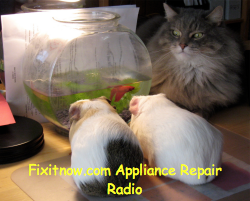 Many of you have emailed the Samurai axing, “Samurai, O Samurai, when will you and Mrs. Samurai make another edition of your award-winning podcast?” You chirped and we listened. After an extended hiatus, we’re baaack!
Many of you have emailed the Samurai axing, “Samurai, O Samurai, when will you and Mrs. Samurai make another edition of your award-winning podcast?” You chirped and we listened. After an extended hiatus, we’re baaack!
Some of the topics covered in this issue:
- Appliance brands: how to choose ‘em?
- New, extended version of the much-loved Home Wiring DVD.
- DIY Appliance repair resources at Fixitnow.com.
- Appliance Service Training Institute conference coming up next week.
The Golden Buttcrack Award
The coveted Golden Buttcrack Award was started by disciples of Saint Applianopoulous, the patron saint of appliance techs. The Award’s name was chosen to honor the destinktive warrior’s stance that St. Applianopoulous would strike as he battled insolent appliances:

The Golden Buttcrack Award is conferred upon those Appliantology Masters who have distinguished themselves by giving exceptional appliance repair help to the heaving swarms of grasshoppers chirping for Appliantological wisdom in the Samurai Appliance Repair Forums. Less than 10 Grand Masters of Appliantology have earned this coveted distinktion. The Golden Buttcrack Masters are:
- RegUS_Patoff
- appl.tech.29501
- kdog
- NSCU_laundry_tech
- Trying to help
- Pegi
- Denrayr
- Willie (aka, Budget Appliance Repair)
You can bask in the glory of the Golden Buttcrack gallery ratcheer.
Samurai Appliance Repair Forum Orphan Prevention Program
Greetings,
After joining your forum under the recommendation of a friend, I was shocked to find that you have to ‘pay’ in order to ask simple questions (I.E: Make a new thread) and to simply get answers that are directed at one’s self in order to repair a rowdy appliance.
-Tom
Hello Tom, and all the grasshoppers out there who are “shocked” that we ask for payment to post in the Samurai Appliance Repair Forums. I would like to ‘splain why this is so, since most of you are probably unaware of the ins and outs of running a Mama-san and Papa-san business on the web. (And, in case you are wondering, this is our main, full-time business that keeps us and our 3 kiddos supplied with a humble thatched roof over our heads and sushi on the table.)
The main reason we charge to post a question on the forum might surprise you. It’s not because the forum represents the collective wisdom and time of a couple dozen battle-hardened appliance techs, whose previously written pearls are displayed for all to see, free of charge, since payment is only requested if you would like to have your particular problem personally attended to by one or more of these professionals. (Although seeing it written out like that makes me think that this alone would be a darn good reason to charge a measly 5 bucks!) No – the main reason that we charge a small fee is for the orphans. (Think of the children!) The orphans are the dozens of posts we used to get every week, back when posting was free, by heartless scoundrels who would post their questions at the forum, only to abandon them there. In other words, a tech would take the time to engage the grasshopper, give some initial advice, and ask for clarifying questions (most topics require a series of interchanges between grasshopper and tech to come to a glorious and satisfying conclusion). But, the rogue would never return, and the topic would just lay there – abandoned, forlorn, and unfulfilled. Worse yet, we discovered that many of these miscreants had similarly posted these same questions on other forums throughout the web, scattering them without any thought to their care and feeding.
Why was this a big deal? Because it would clutter the forum with unresolved questions, distract the techs from helping people who were engaged and attentive to their topics, and generally dishearten those of us who were working so hard to leave no topic behind. Now, with this small commitment that we ask of people, the forum is rocking with engaging back-and-forth interactions between grasshopper and expert resulting in a treasure-trove of satisfyingly complete repair stories.
The Samurai and I do feel for our grasshoppers who don’t have it easy these days. While $5 isn’t worth a whole lot anymore, it can still mean a lot to those who are suffering from the effects of our bankster-run economy. Last year the Samurai and I heard your chirps of distress and provided a no-cost way to earn posting privileges at the forum: the Appliantologist Merit Exam. We’ll keep looking for other alternatives to charging for forum posting that would still prevent the sad orphan topics that used to be left on our door step.
Thanks for visiting Fixitnow.com!
~ Mrs. Samurai
Smart Grid: Green Dream or Just Another Big Brother Control Grid?
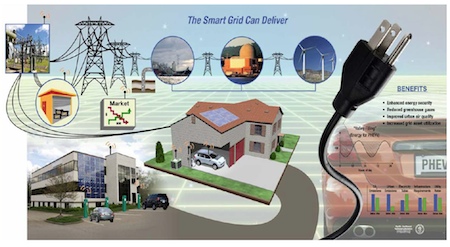
What is Smart Grid?
Smart Grid is a planned enhancement to the existing power distribution grid that will, in theory, have the capability of meeting growing electricity demand by more efficient distribution without having to build new power plants. One of the ways this lofty goal will be accomplished is by using two-way technology. Where the current power grid is one-way– power flows out from the power plant, through the grid, to the end user with no feedback or communication with the power plant– the Smart Grid will be two-way, meaning it will send back information to the power plant (and government regulators) on how the electricity is being used, in what types of machines, by whom, and for how long. It’s this “two-way” bidness that makes Big Brother smile and should make you cringe.
Who Likes It?
- Government
- Utilities
- Environmental Groups
Government
Government, especially the Ameedican gubmint, has a long history of using technology to spy on its citizens, especially in recent years (e.g., Patriot Act, Project ECHELON, Total Information Awareness initiative, etc.).
Government likes Smart Grid because it gives them what governments always want: control; specifically, more control over the sheeple. Smart Grid gives them this through its two-way technology, which allows them to monitor not only how much electricity you’re using but how you’re using it and for what types of appliances.
For example, they can look at your total power usage and, say, 60% of it is accounted for from Smart Grid-enabled appliances. That leaves 40% of your usage unaccounted for. So, gubmint, which embodies the unfortunate combination of Rambo and the Keystone Cops, automatically assumes you must be doing something illegal, like running an indoor pot garden using high-energy grow lights. Next thing you know, DEA is raiding your house at 2am, shoots your dog and ransacks your home only to find that all you have is a tanning bed.
This power monitoring is effectively a form of surveillance over you for gubmint bureaucrats. You think gubmint will use this information wisely? Well, you must absolutely love the way they handled New Orleans in the wake of hurricane Katrina, the bankster bailouts, the Patriot Act (which was only supposed to be used for terrorists) being used against pot smokers, standing in long lines at airports while waiting to be fondled and groped by TSA thugs, and having 3-D, full-detailed pornographic electronic images taken of your wife and daughter.
When will the sheeple finally wake up and realize this is just another scam, another power-grab by a perverted gang of criminals calling themselves “your government” to exert more control over your life and keep you enslaved like a good little serf? To the criminal cabal in Washington, Smart Grid is yet another way to exert neo-feudalism, keep you on the plantation, invade your privacy and ration your electricity use. Think I’m exaggerating? It’s stated right inside DOE’s happy talk Smart Grid propaganda brochure on pages 17 and 18. You can download the entire puff-piece here.
Utility Companies
If you haven’t figured it out already, we blew right past socialism and have arrived at full-on fascism in Amerika today. A quick refresher for the Illiterati: “Socialism” is where all the losses and the gains are socialized; everyone, including big corporations, are all floundering in the same sewer together. “Fascism,” on the other hand, is where the losses are socialized but the profits or gains are privatized. The most recent and brazen example of this was the banker bailout– they gambled with huge amounts of money and, as long as it worked out in their favor, they kept all the profits; but when they lost big bucks, we the tax-paying suckers, had to bail them out. So, in a fascist system, when the special corporate interests make money, they keep it and the sheeple get nothing; when they “lose” money, the sheeple pay for it and they don’t really lose at all. It’s a game of “heads they win; tails we lose.”
The utility companies claim that Smart Grid will let them have more “granular” control over power production and have more awareness of power failures. Currently, when power goes out in an area, the only way the power company knows about it is when someone phones it in. The two-way nature of Smart Grid enables them to know automatically when part of their grid goes down. But this comes at a huge price for us. And, besides, is it really such a burden to call in a power outage? Our power goes out regularly and we just call in the outage to the power company’s toll-free automated power outage line and they dispatch a crew to fix it. What’s the big deal?
The real reason power companies like Smart Grid is because it will enable them to create artificial scarcity scenarios and thus increase rates. It doesn’t take much grey matter to foresee a situation where the power company is low on power during a peak demand period and they have a choice: supply power to Joe Sixpack at (relatively) low rates or to a commercial or industrial customer who pays sometimes two or three times the residential rate. Hmm, decisions, decisions.
Smart Grid represents yet another merger of government and corporate interests. They’re in bed together and each stands to benefit in specific ways from Smart Grid which boils down to this: more control and surveillance over we the sheeple, higher electricity costs, and less electricity available when we want it, even if we’re willing to pay for it.
Environmental Groups
The “Warmistas” or Green Nazis, the tools of the global elite, are all ga-ga over Smart Grid because they’ve been conned into thinking that it’s good for the earth, man. These are the same gullible, useful idiots of the global elite who’ve bought into the whole man-made global warming scam, which was proven to be a scam (and a conspiracy) when a decade’s worth of emails and falsified data were leaked by investigators on the inside. But, hey, don’t take my word for it– read the Climategate Files for yourself.
Conclusion
Smart Grid is touted as a way to extend the capabilities of an aging and ailing power grid system, to deliver power to meet ever-growing demand without building additional power generating plants. If that right there doesn’t scream “rationing” to you, then you’re either stone deaf or dumb as a rock.
So what’s the answer to meeting increased power demand? Simple: build more frikkin’ power plants! “Oh, no!” come the shrill cries from the green weenies, “that’ll increase pollution and *gasp* global warming!”
Stop falling for that bovine excrement. Now that global warming has been proven to be a Big Lie we can take that card off the table. As for other types of pollution, such as sulfur and nitrogen oxides which cause smog and acid rain deposition, these are real concerns. But they can effectively be dealt with using modern air pollution control technologies. These are engineering problems, and solutions for them have been around since before I was a graduate student in Environmental Systems Engineering at Clemson University in the mid-1980’s. Engineers solve these kinds of problems every single day.
The biggest impediment to building new power plants is the government red-tape and strangling regulations. No one in their right mind is going to invest capital into building a power plant, whether coal-fired using clean coal technology or nuclear, if they see no possibility of earning a return on that capital. Sorry, folks, that’s the way the real world works, no matter what Karl Marx (or his surrogates in American universities) tells you.
And now, brothers and sisters, let us conclude this screed with a haiku. Fire up a spliff and chant along with me now…
DOE says it’s great for
controlling us serfs.

